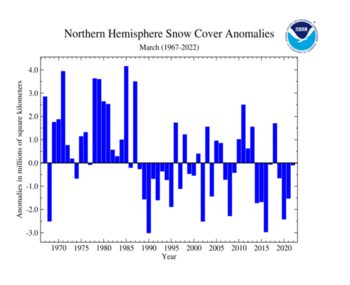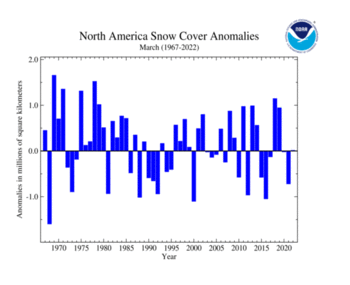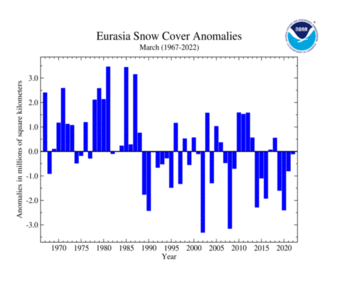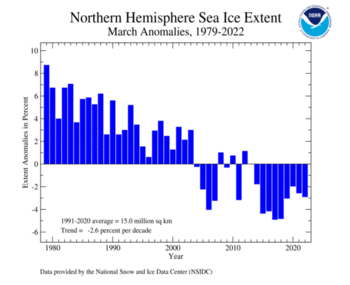NH Snow Cover Extent
| March 2022 | Snow Cover Extent | Anomaly 1991-2020 | Trend per decade | Rank (56 years) | Record | ||||||
|---|---|---|---|---|---|---|---|---|---|---|---|
| million km² | million mi² | million km² | million mi² | million km² | million mi² | Year(s) | million km² | million mi² | |||
| Northern Hemisphere | 40.04 | 15.46 | +0.25 | +0.10 | -0.44 | -0.17 | Largest | 31st | 1985 | 44.28 | 17.10 |
| Smallest | 26th | 1990 | 37.12 | 14.33 | |||||||
| North America | 15.65 | 6.04 | -0.05 | -0.02 | -0.05 | -0.02 | Largest | 32nd | 1969 | 17.29 | 6.68 |
| Smallest | 25th | 1968 | 14.04 | 5.42 | |||||||
| Eurasia | 24.39 | 9.42 | +0.30 | +0.12 | -0.39 | -0.15 | Largest | 33rd | 1981 | 27.95 | 10.79 |
| Smallest | 25th | 2002 | 21.18 | 8.18 | |||||||
| Ties: 2001 | |||||||||||
Data Source: Global Snow Laboratory, Rutgers University. Period of record: 1967–2022 (56 years)
Following three consecutive years of below-average snow cover extent, the Northern Hemisphere snow cover extent for March 2022 was near average at 40.04 million square km (15.46 million square miles).
North America's snow cover extent during March 2022 was 15.65 million square km (6.04 million square miles), which is near average. During March, above-average snow cover extent was observed was observed across parts of southwestern Canada, northern Rocky Mountains and northern Great Plains. However, below-average March snow cover extent was observed across parts of western contiguous U.S. and its northern tier. Alaska had its fifth-largest March snow cover extent and Canada had a near-average extent for the month. Meanwhile, the contiguous U.S. had its seventh-smallest March snow cover extent on record.
The Eusrasian snow cover extent was also near-average at 24.39 million square km (9.42 million square miles). During the month, above-average snow cover extent was observed across parts of southwestern Russia, Turkey, northern Kazakhstan, northeastern and southwestern China. Below-average snow cover extent was observed across parts of eastern Europe, southern Kazakhstan, Mongolia and parts of southwestern China.
Sea Ice Extent
The sea ice extent data for the Arctic and Antarctic are provided by the National Snow and Ice Data Center (NSIDC) and are measured from passive microwave instruments onboard NOAA Satellites. The sea ice extent period of record is from 1979–2022 for a total of 44 years.
| March 2022 | Sea Ice Extent | Anomaly 1991-2020 | Trend per decade | Rank (44 years) | Record | ||||
|---|---|---|---|---|---|---|---|---|---|
| million km² | million mi² | Year(s) | million km² | million mi² | |||||
| Northern Hemisphere | 14.59 | 5.63 | -2.93% | -2.53% | Largest | 36th | 1979 | 16.34 | 6.31 |
| Smallest | 9th | 2017 | 14.29 | 5.52 | |||||
| Southern Hemisphere | 2.86 | 1.10 | -29.90% | +0.98% | Largest | 43rd | 2008 | 5.28 | 2.04 |
| Smallest | 2nd | 2017 | 2.70 | 1.04 | |||||
| Globe | 17.45 | 6.74 | -8.69% | -1.78% | Largest | 43rd | 2008 | 20.46 | 7.90 |
| Smallest | 2nd | 2017 | 16.99 | 6.56 | |||||
Data Source: National Snow and Ice Data Center (NSIDC). Period of record: 1979–2022 (44 years)
The March 2022 Arctic sea ice extent averaged 14.59 million square km (5.63 million square miles), which is 840,000 square km (320,000 square miles) below average. March 2022 also marked the ninth consecutive March with below-average sea ice extent. Regionally, the Bering Sea and Baffin Bay had their largest March sea ice extent since 2013 and 2015, respectively. Meanwhile, the Sea of Okhotsk had its smallest March sea ice extent since 2015.
During the Northern Hemisphere winter, the Arctic sea ice expands typically reaching a maximum extent in March. Once the maximum extent is reached, it marks the beginning of the Arctic melt season. According to preliminary data from the NSIDC, the Arctic reached its annual maximum sea ice extent on February 25, 2022, which is 15 days earlier than the 1981–2010 median date of March 12 and tied with 2015 as the second earliest data on record in which a maximum extent was reached. The years 1987 and 1996 had an earlier maximum date (February 24). The annual extent was 14.88 million square kilometers (5.75 million square miles), which is 770,000 square km (297,000 square miles)—about the size of the country of Turkey— below average and ranks as the 10th-smallest annual maximum extent on record. The four lowest annual extents have occurred from 2015 to 2018.
The Antarctic sea ice extent for March 2022 was the second smallest for March in the 44-year record at 2.82 million square km (1.09 million square miles) or 1.21 million square km (470,000 square miles) below average. Only March of 2017 had a smaller sea ice extent at 2.70 million square km (1.04 million square miles).
While the Arctic reached its annual maximum extent on February 25, the Antarctic reached its annual minimum extent on the same day, which is only one day later from the median date of February 24 for the minimum extent. This year's minimum extent was 1.92 million square km (741,000 square miles), which is 930,000 square km (359,000 square miles)—or about the size of the country of Nigeria—below average. This was also the Antarctic's smallest annual minimum extent on record and marked the first time since records began in 1979 that the minimum extent fell below 2 million square km (772,000 square miles).
 NOAA's National Centers for Environmental Information
NOAA's National Centers for Environmental Information




